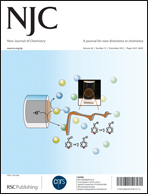Aluminium(iii) porphyrin based axial-bonding type dyads containing thiaporphyrins and expanded thiaporphyrins as axial ligands†
Abstract
Four axial-bonding type Al(III) porphyrin based dyads, containing thiaporphyrins with N3S 1 and N2S22 cores and expanded thaiporphyrins with N2S33 and N2S44 cores, were synthesised by treating [(TPP)AlIIIOH] with the corresponding mono-functionalised meso-4-hydroxyphenyl thiaporphyrin or expanded thiaporphyrin building blocks in


 Please wait while we load your content...
Please wait while we load your content...